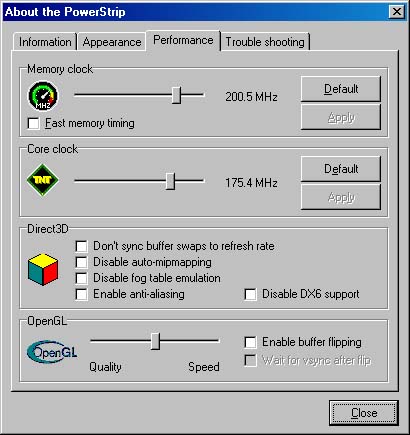Hardware
Audio
Controllers
General
Mainboards
Memory
Modems
Monitors
Portables
Printers
Processors
Scanners
Storage
Video
Games
Reviews
Previews
Cheats
& Hints
News
General Info
|
Tweaking & Overclocking Hereís an important issue that everyone wants- to be able to tweak their graphics cards for better performance and image quality. Nowadays, every manufacturer includes advanced options to their graphics cards so that users may tweak the cards through the display properties. For example, color correction, monitor selection, screen adjustment and advanced options for configuring 3D APIs such as Direct3D and OpenGL. Nowadays, overclocking is taking place in graphics cards as well, so many manufacturers are supporting it by offering built-in overclocking through the display properties. First, weíll talk about the tweaking options that can be found on the various cards in this roundup. The ASUS AGP-V3800 Ultra Deluxe has plenty of such options and these can be activated by clicking on the task bar icon, which brings up a PowerStrip style menu with everything from refresh rates to color calibration. On the display properties, an advanced display box allows you to tweak Direct3D, OpenGL and the VR glasses provided with the kit. But keep in mind that there are 3rd party utilities to control the video-in features of the card. The Creative 3D Blaster TNT2 Ultra has only a few options for tweaking. The advanced menu contains a few OpenGL and Direct3D options along with an overclocking utility. But of course, remember that the display drivers are still in beta. As for the Diamond Viper, well, what can I say... I liked it a lot, especially the overclocking utility and the ability to individually set profiles for your applications. Donít forget that InControl Tools 99 is also provided with the pack. Itís a very good utility, which gives the user many more options on the display than the standard. The Xentor 32 also has a average bunch of options through the display properties, OpenGL and Direct3D tweaking but no overclocking support. On
the other hand, the Dynamite TNT2 Ultra has better support and options,
touch desktop management utilities and the MoniTune utility for customized
monitors. The Dynamite also has a built-in overclocking utility called
the HercuMeter for overclocking the card.
So actually stability may vary from sample to sample. This theory applies to all boards, but I did test two Hercules boards and they both made it up to 195/225MHz without problems. Also, please donít forget that if you do choose to overclock, you do so at your own risk. We cannot be held responsible if you mess up your card, so try not to mess it up. Donít try overclocking at all if youíre not comfortable with the idea. If
you do choose to overclock, youíll need to use either the built-in overclocking
utility from the card manufacturer or a third-party utility such as PowerStrip
2.5 if you opted for one of the cards without built-in overclocking
utilities. Also, the utilities provided with the boards are often limited
to lower clock settings,
One more thing. High settings are often stable when youíre at the desktop, but the card may start locking up after playing games because they utilize the graphics controller a lot more and would eventually produce more heat. So if you want to settle down for a certain setting, do what I do and have the Quake II time demo running for 24 hours before making a call. Keep in mind most of these TNT2 cards donít always work properly at a bus speed of 83MHz because of the high AGP clock. I tried the five cards on a Celeron 366 system set to 456MHz by a 83MHz clock, and all the cards started locking up on the Quake III test after several minutes. I tried three motherboards, the Abit BH6, the ASUS P2B-F and the AOpen AX6BC. But this is the only troublesome setting and allowing for that, the cards worked nicely on higher bus speeds above 133MHz, provided that there is a 2x clock ratio for the AGP bus on the motherboard. |
|
|
|
|
